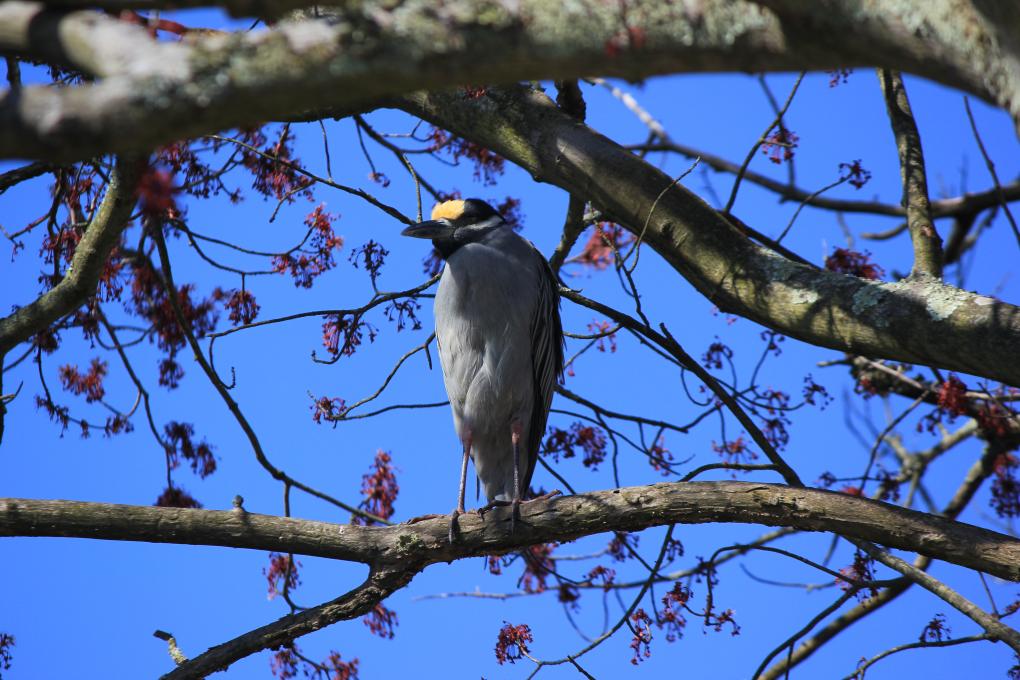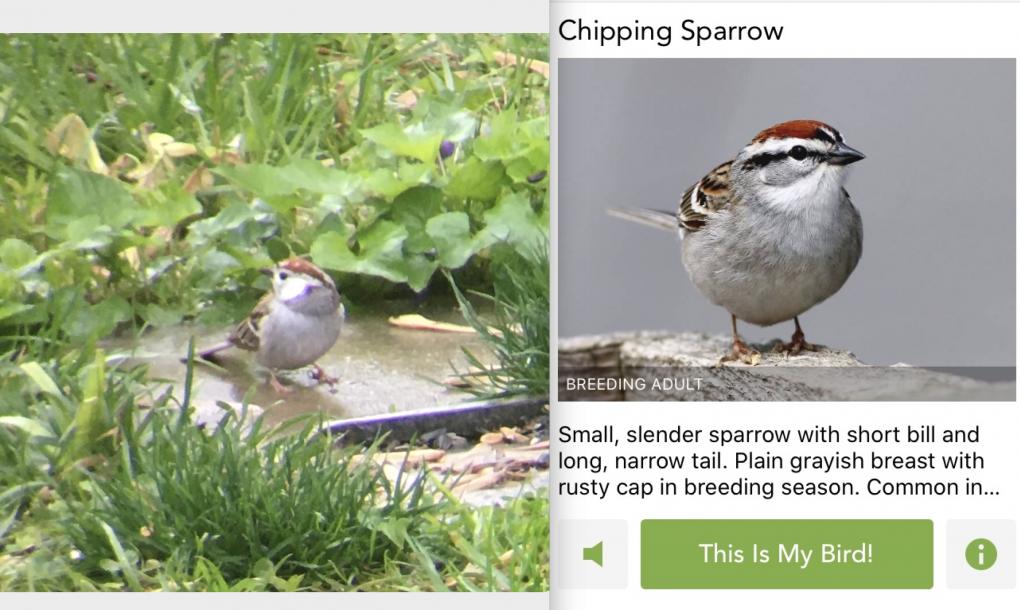The Cornell Lab Bird Academy › Discussion Groups › Joy of Birdwatching › Activities: Local Bird Exploration
-
My backyard in Long Island New York has started to see some new visitors with the coming of Spring and warmer weather. The last 3 weeks have brought us Brown-headed Cowbirds, Yellow-rumped Warblers, and American Goldfinch's. My eyes are open for more visitors as it warms up more. Stay safe and healthy everyone.
-
1. The birds that I saw were: Sulphur Crested Cockatoo, Rainbow Lorikeet, King Parrots, Noisy Minors, Crimson Rosella, and Currawong 2. I have checked on Merlin for the birds most likely to be found in our area. Going out to look for them is not practical at the moment. I will however go asap. I will also continue to watch from our back deck. 3. 5 birds that apparently can be found in our area that I have not seen are: Little Lorikeet, Eastern Yellow Robin, Rose Robin, Eastern Spinebill, and Golden Headed Cisticola. I am on their case!
-
By sitting long enough and quietly, I guess, more birds flew close but I’m still sorting out which hummingbirds and songbirds are visiting. Using the Merlin app photos and songs/calls actually confounded things, as there are overlapping color patterns and my ear is not refined. I love to learn, yes, but the joy of birdwatching for me is in the watching and the listening, and talking to them, to the gestalt of sharing space with them. I did use “explore birds”, and look forward to noticing if the soaring swift I see has a white throat, spotting the forked tail of the barn swallow, catching the sweet song coming from the plain brown-ness of the house Wren, spotting the distinct black phoebe (name source for the daughter of a birder friend), and looking at the woodpecker in our nearby oak grove to see it looks like a Nutell. Also, when restrictions lift, and I can visit my Dad again, I want to see the Northern Road Runner with babies that he watches from his back porch in the mornings.
-
We spent the day at Griggs Reservior and then Walnut Woods Metro Park (Columbus, Ohio). My sister and 11 year old nephew went to Griggs with us to try out birdwatching. Ian, my nephew, was good at spotting birds with his young eyes but got bored easily. Oh well! We saw barn & tree swallows, Baltimore Orioles, Yellow-rumped Warblers, Yellow Warbler, Palm Warbler, Eastern Kingbird at Griggs. My huband and I then saw House Wren, Orchard Oriole, Cowbirds, Eastern Towhee and Field Sparrows at Walnut Woods. We used Merlin a lot. At Walnut Woods we were walking and saw a bird in the distance. We couldn't make it out very well because the forest was a bit dark so we used the Merlin app to narrow down what it might be. I suspected that it was an Eastern Towhee so we played that song on our phone. Immediately, the bird flee to a tree next to us and sang back to us. It was so close! I guess it thought it had found a mate or something. See our picture below (plus a few more from yesterday's outing.)



-
1. During my observations I spied Cassin's Finch, Black-capped Chickadees, magpies, Hairy Woodpecker, Bullock's Oriole, robins, Ruby-throated Hummingbird, Vesper Sparrow, Red-winged Blackbird, Canada Goose, and five Sandhill Cranes. 2. I love Merlin. Most all those on the "Most Likely" to see today, I saw except for the Song Sparrow. 3. Most of those I selected, interestingly, happen to be shore or water birds which do inhabit our county but are in habitats unlike where I live. They included the American Coot, Wilson's Snipe, Sora, and then I hope to see, near where I live, the Pygmy Nuthatch and the Belted Kingfisher. I've really enjoyed using the resources available through our classwork. I've also added the National Geographic Guide to Birds in Western North America. I, too, need a better zoom lens for my camera! Could someone explain why the Bullock Oriole, I believe, was once called the Northern Oriole?
-
Sitting in my back yard around 6:00 p.m. and observing my yard and an open behind it, I saw grackles, house sparrows, Inca and whitewing doves, some kind of flycatcher (ash-throated and Great crested, couldn't tell), a hummingbird (I think buff-bellied), and two mockingbirds that were...doing a mating dance? Not sure; I've never seen that behavior before. Usually if I see two mockingbirds, one is trying to drive off the other. These two were on the ground doing what looked like a Mexican hat dance, sort of circling and doing a tapping step. Also I could hear a killdeer, a mourning dove, a kiskadee, and some kind of oriole (I think). Looking at eBird for this month for my county was pretty amazing. I was surprised at the number of birds I associate with water, ducks, for instance. We don't have a lot of large water features in our county, besides the Rio Grande, but I know there are small ponds and lakes on private ranches, and irrigation canals, and I guess collectively they offer more water resources than I realized.
-


 This section's activities prompted us to use our local Audubon Society's bird map to explore locales new to us. Cornell's E-bird site led us to lesser noted sites so as to seek out out less foot trafficked places. Using our optimized binoculars, and the well loved Merlin App, we identified buffleheads and a turkey vulture along the shore. The red-winged blackbirds were everywhere with their distinctive sounds. When we returned home the Black-capped chickadees were defending their territory (as usual) with the American Goldfinch. As Brown thrasher's have taken up residence in Arborvitaes adjacent to the bird feeder the Chickadees have been forced to relocate to yews in the backyard. Thanks to the course we're using bird behavior as an added discriminator for bird identification!
This section's activities prompted us to use our local Audubon Society's bird map to explore locales new to us. Cornell's E-bird site led us to lesser noted sites so as to seek out out less foot trafficked places. Using our optimized binoculars, and the well loved Merlin App, we identified buffleheads and a turkey vulture along the shore. The red-winged blackbirds were everywhere with their distinctive sounds. When we returned home the Black-capped chickadees were defending their territory (as usual) with the American Goldfinch. As Brown thrasher's have taken up residence in Arborvitaes adjacent to the bird feeder the Chickadees have been forced to relocate to yews in the backyard. Thanks to the course we're using bird behavior as an added discriminator for bird identification! -
this morning, I was able to see and hear Cardinals, a Mockingbird, Crows, and Field Sparrows. I saw a Phoebe, a Kingbird and a Bluebird. I also saw four Turkey Vultures. My walk lasted more than 15 minutes, but time flew by with so many birds to see and hear.
-
This morning here in North Myrtle Beach, SC, I saw several Northern Cardinals, House Finches, and Black Capped Chickadees at my feeders and in the trees. I also saw one Mourning Dove and a few American Robins roaming around. They’ve taken a break from eating for now and I can hear the Cardinals in the trees. I plan to bike to a nearby lake today to see who I can see and hear from the Most Likely list. I am also at the beach most days, either walking or sitting, and always have a hard time positively identifying some of the sea and shorebirds with the guide I carry with me. I am sure Merlin is going to be a good improvement in helping me to learn these birds!
-
May 1,2020 Cincinnat Nature Center, Milford, Ohio. I observed several local bird species today including, the Red Winged Blackbird, Red bellied Woodpecker, Downy Woodpecker, Mourning Dove, Blue Jay, male Cardinals at the ourdoor bird feeder in this private nature preserve. The weather at 12 n oon is cloudy , overcast and chilly for early May. I am a member and also a volunteer Ambassador at this nature center. also I participat e in the Cornell Lab Project Bird Feeder Watch from November to April each year and send local bird count data to Cornell each winter. IN comparison, My home backyard had only robins in pine trees and hunting worme on ground.
-
Activity 1: Watching from my yard: European Starling, House Finch, House Sparrow, Eurasian Collared Dove, Mallard, Lesser Goldfinch. (The mallards were a big surprise.) Activity 2: At Antelope Island State Park yesterday, I heard a song in the sagebrush. I couldn't see it, so I pulled up Merlin's most likely. The first bird on the list turned out to be what I was looking for: Western Meadowlark. Activity 3: Birds that I didn't know were in my area: Barn Swallow, Ring-necked Pheasant, Lazuli Bunting, Double-crested Cormorant, and Yellow Warbler.
-
Activity 2: Sounds. California Quail, American Robins for sure, Song Sparrow, noisy Red-winged Blackbirds, Canada Geese were quiet under a large tree (They are most noisy when about to take off. They are most plentiful on our large lake). California Quail makes a sound like they are saying boo. lol. Was hard to see the small birds in the large, overgrown marsh area today, but I was sure I saw House Finches, and listening to the sounds on my app it was definitely them. I have to find Chickadees! So cute! But listening to their song on the app, I did not hear one today.


-
Is your first photo of an Audubon's (Yellow-rumped) Warbler? We have those near my house too! They came back about two weeks ago... I always think of California Quail as saying "chi-CA-go ... chi-CA-go" - one of may favorite calls, always makes me laugh.
-
-

 Activity 1: I went to one of our many marsh areas. There were the usual Mallards, Canada Geese, red-winged Blackbirds, Yellow-rumped Warblers which I am seeing for the first time (this is their breeding area), sparrows (I think they were Song Sparrows but they were moving in and around thick bush), American Robin (I have seen these my whole life and I did not know the full name. We have always said it is spring when we see the Robins). I love to watch the California quail; so cute. Didn't see any little ones yet. I heard what I think was Chickadees, but they were very high up in the trees. There were some big nests up there too, but I did not see any birds around them. Owls do inhabit this area.
Activity 1: I went to one of our many marsh areas. There were the usual Mallards, Canada Geese, red-winged Blackbirds, Yellow-rumped Warblers which I am seeing for the first time (this is their breeding area), sparrows (I think they were Song Sparrows but they were moving in and around thick bush), American Robin (I have seen these my whole life and I did not know the full name. We have always said it is spring when we see the Robins). I love to watch the California quail; so cute. Didn't see any little ones yet. I heard what I think was Chickadees, but they were very high up in the trees. There were some big nests up there too, but I did not see any birds around them. Owls do inhabit this area. -
Hi Sandra. Love your quail picture. It looks so regal! Cathy
-
-
While looking out my patio door I saw Robins, Cardinals, Blue Jays, Canada Geese and sparrows. I didn't know that I might see yellow or black billed Cuckoos, common tern and blue grosbeak.
-
Activity 1: I watched the feeders and birdhouses in our yard/field. I saw mainly common birds today: Northern cardinal, blue jay, red wing blackbird, common grackle, mourning dove, gray catbird (they love hanging out in our arborvitae trees), robin, downy woodpecker (on the suet as always) and at the houses we have tree swallows, house sparrows and Eastern bluebirds who have all nested and flit in and out. Activity 2: I had not used the Merlin bird app before this course and I really enjoy having that information at my fingertips! Knowing what's most likely to be seen helps me to identify the birds easier. Activity 3: The 5 birds that I didn't know about in my area that I read about were: chimney swift, killdeer, green heron, ovenbird, and Northern flicker (which coincidentally I then saw the next morning at the top of a tree in the field).
-
Activity 1: I regularly watch for birds on my balcony. I live close enough to a large river for their to be a range of water fowl and migrating species that show up, but also on a residential street so get a mix of birds that love to hang out near humans. An example of the two extremes is seeing Great Blue Herons, Canada Geese, and Double-Crested Cormorants flying overhead, while listening to the cacophony of House Sparrows, Northern Cardinals, and Rock Pigeons at the same time. Activity 2: I use Merlin all the time while I'm in the field and also at home. In the field, I mostly use the Bird ID feature to help me ID things I see. It has proved super useful! At home, I also love to use the explore birds feature, especially the view that allows me to see bar charts for my area, which lets me know what birds are common or are soon to be common for my area that I haven't yet seen. Both in the field and at home, I also often listen to bird vocalizations to help me figure out what I'm hearing while outside. I've been amazed at home much my birding has become auditory as I've gotten into it -- I totally expected birding to be entirely about seeing, but hearing is just as important, and perhaps will become even more important for me as trees and bushes leaf-out, making birds harder to observe visually. Activity 3: I've been doing this a bunch lately. I love to check out what birds people are finding in my area that I haven't yet seen. Before I started observing birds more closely, I was basically ignorant of how much bird migration happened in my area. I knew all about migrating geese, but I ignored how many of the other species migrated as well, and also which ones stuck around, and all of the questions behind why some left and some stayed, etc. The range maps on All About Birds and the Bar Charts on eBird have been super helpful in teaching me about who migrates when and to where. I love it! One bird I'm looking forward to discovering is a bird that bar charts tell me is about to start showing up in big numbers here -- the Yellow Warbler. I've never seen it before, but realized it would be coming soon by checking out the Merlin list of most likely birds in my area with accompanying bar charts for monthly frequencies.
-
I am thoroughly enjoying this course, and it has been great to read comments from fellow birders from all over the country. I live on the river, and have both a lawn and woods on our property. Today I have seen a Northern Flicker, Redheaded Woodpecker, Robin (of course!), Grackles, Starlings, and an Eastern Phoebe. Merlin said that bird was rare, but I got a great look at it, and it was a perfect match. The course has been very helpful in terms of knowing which features to look for. I hope to learn birds by sound. My son-in-law can identify all the area woodpeckers by sound. I am finding it very difficult, but hopefully it gets easier by time.
-
I live at the beach in New Jersey, so I am not sure if I will see the same types of birds as most people in this class. I always see cardinals, grackles, American goldfinch (New Jersey state bird), Purple finch, sparrows (not sure what kind yet) and crows...not to mention a lot of shore birds. I am sad that we never get hummingbirds though because they are my favorite. I hang a feeder out every year, but I was told that we just don't have enough vegetation on our barrier island to sustain them. I keep trying though. I usually see one a year in September, probably migrating south. There are plenty of them on the mainland nearby though. We have had an unusual visitor the past few years. A group of yellow-crowned night herons hang out in a tree across the street from my house. The first two years, they had nests, but storms blew it aways this year. They still hang out by the tree, but have not rebuilt a nest. I was told that they often build nests in several locations. Looking forward to learning a lot about local birds. I need to get a good field guide, a good pair of binoculars and a better long distance lens for my camera.

-
Beautiful night heron!
-
-
1. Watching my bird feeders this afternoon, all I am seeing are the White Crowned Sparrows - so many of them - they are cleaning out my feeders daily. It is quite windy right now so no other birds seem to be in the yard. 2. Someone in my neighborhood posted a pic of an American Goldfinch. I hadn't seen any around, and yesterday on our walk I heard a lot of singing coming from the trees - I used my app to identify the song and it said American Goldfinch. As I got closer to the tree I could see about 10 birds singing in there - so cute! 3. I didn't know that American Kestrel or Brown Headed Cowbirds were here. I saw a Kestrel in Oregon before. Yesterday I also saw the Brown Headed Cowbird for the first time - had to look it up - I knew it was different from what I had seen before. Enjoying this course so much and learning many new things!
-
Charleston, SC. I enjoyed this activity. It also inspired me to Save and share my list With a birding friend in Jalisco, Mexico. She sees so many more birds than me, but we did have some birds in common. Loving Merlín and ebird! Also still researching new binoculars. If you have a favorite, let me know so I can evaluate them.
-
Activities two (I'm doing it based on the walk I took yesterday and the birds saw then as it is rainy today. There are many more species in my area than I might have guessed. I've seen Robins, Blue Jays, Downy Woodpeckers, Mallards, Red Winged blackbirds and various sparrows, but there are many birds to look for that I have either not noticed or aren't here right now. Activity 3 There are ALOT of birds in my county that I had no clue about including the wide variety of geese and ducks that are around, these include Green-Winged Teals, Wood Ducks, Blue-Winged Teals , Mergansers, Grebes, Yellow-Billed Cuckoo, various Rails, various flycatchers, more birds of prey than I knew. Really there is far more variety than I ever imaged here. Will have to get exploring.
-
Activity 1. What a wonderful exercise, and I confess to spending more than 15 minutes on it! Before I knew it, the entire morning had passed… In all, I spotted 17 different species.
- Many were familiar to me from previous visits (e.g., Carolina Chickadee, White-breasted Nuthatch, Northern Cardinal, etc.), but a few I hadn’t seen since last year (e.g., Gray Catbird, who, from its range map, seems to winter along the Gulf Coast).
- One bird, which I wasn’t able to positively ID is pictured below left. He moved about on the ground and was smaller than a House Sparrow. Merlin ID suspects him of being a Chipping Sparrow, but his all white face is throwing me off. What do you think? Has anyone else seen a bird like this?

-
Yes, that's a Chipping Sparrow. However, it's an abnormal one with an albino-like white patch on the face. Things like this happen relatively frequently, so beware of big white patches, especially if they're not symmetrically placed on both sides of the body.
-
@Kevin Thanks for the add'l info, Kevin! I'll keep an eye out for lil' "Whitey" -- I've since seen 4-5 Chipping Sparrows at a time (foraging for insects on my patio). Hopefully, Whitey's pals won't hold his abnormality against him.
-
@Jay Yeah! In birds, when it is a white patch like that it is called "Leucism" - which is similar to albinoism. There is a leucistic House Finch that returns to my mom's backyard feeder every spring. Interesting that yours is also missing the black eye stripe. Coincidentally, I saw my first Chipping Sparrow during this exercise today. :)
-
I saw a nice yellow bird finally investigating the bird seed I put out. I thought it was an American Goldfinch, but it didn't have a black forehead, and it didn't come in a cute little flock. It was mostly dusky yellow, but not brownish like female goldfinches. It wasn't a Yellow Warbler because those birds are insect eaters. I was showing a family member all the online bird resources I know of, and we watched several live bird cams. It was fun seeing baby osprey and their mom. We looked at the Sapsucker Woods bird feeder right when a big squirrel was sitting in the box! There was a mourning dove, I believe, that the squirrel really didn't like. That was the only bird the squirrel seemed to scare away. After the squirrel left, lots of birds stopped by.
-
It is a drizzly type of day but in a 15-30 minute span at my feeders, I've seen House Finches, Gold Finches, Tufted Titmouse, Northern Cardinal, Chipping Sparrow, and House Sparrows. So thankful that I have some feeders up and have attracted a decent variety of birds in my more urban setting, although the city is designated a Tree City.
-
Activity one. It's drizzly and cold by me today so I looked at the Sapsucker Woods webcam which was hopping with birds even in the rain. I saw a pushy grackel and then another behind the feeder looking on, 3 blue jays, 2 red wing blackbirds, 2 starlings a mourning dove, 2 birds I think were mockingbirds, 1 male cardinal and what I think was a female or juvenile cardinal. This last was hard and the id apps weren't helping. I guess the crest can go up or down and that makes it confusing. In this case the didn't appear to be a crest. Also, 2 downy woodpeckers
-
I've often found that their crest do go down when they feed and often if you see a male cardinal, a female will be nearby as they do breed for life, I believe.
-
@Katie Thanks for that information Katies
-
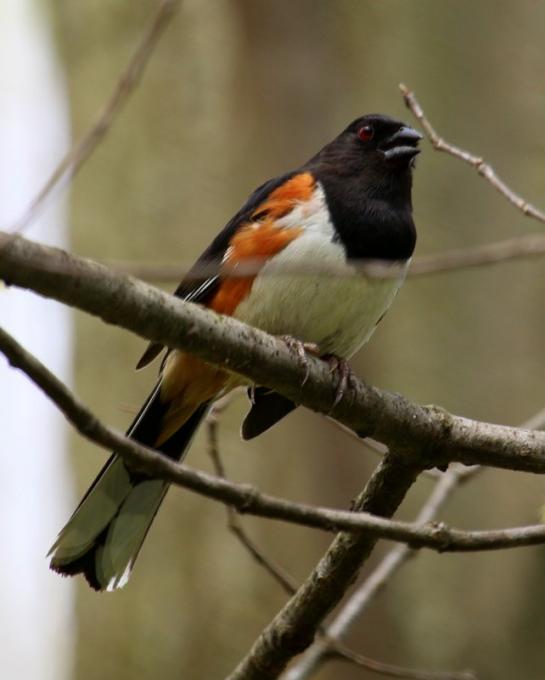
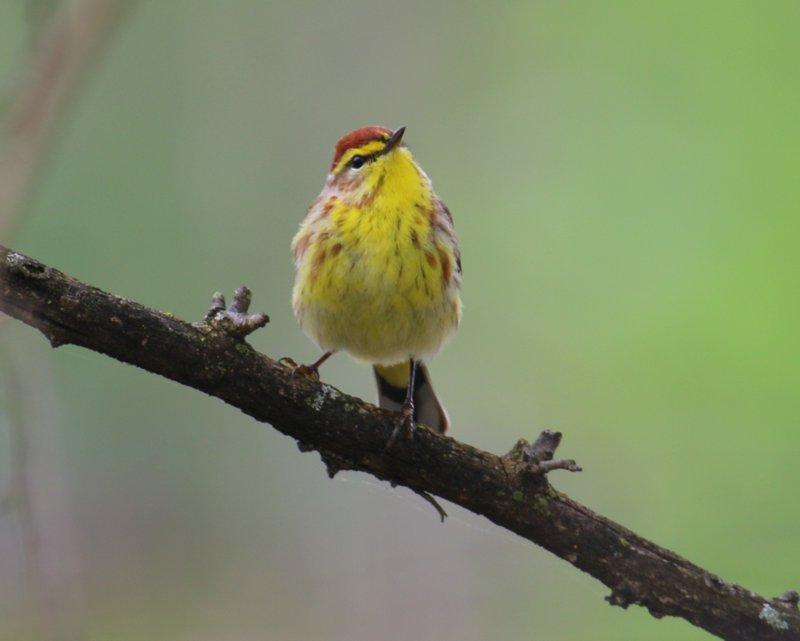
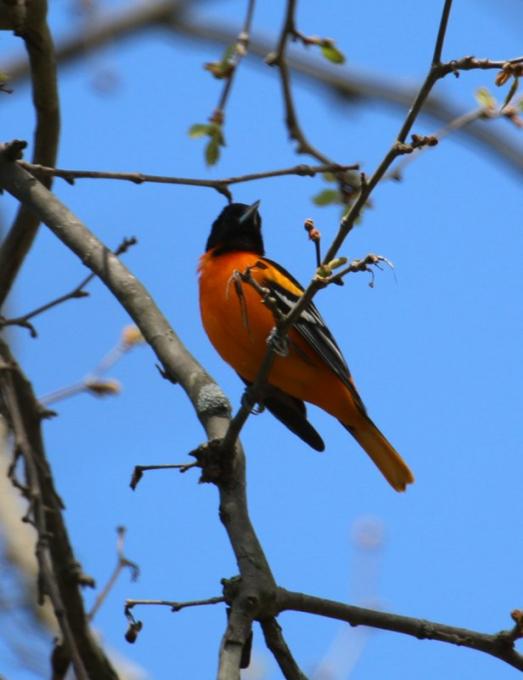
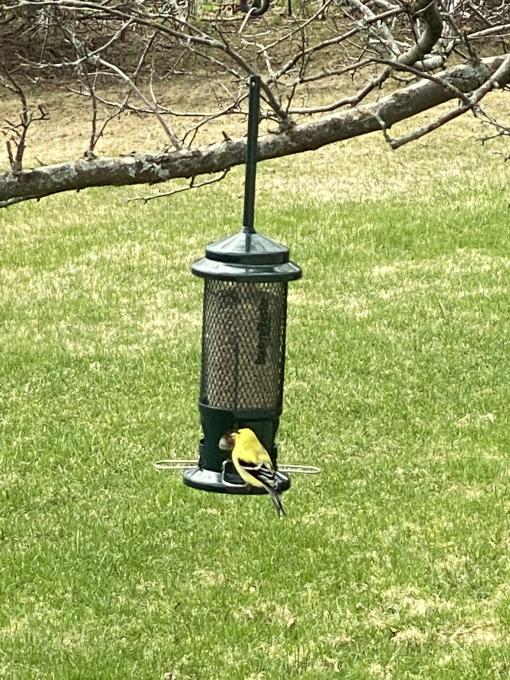
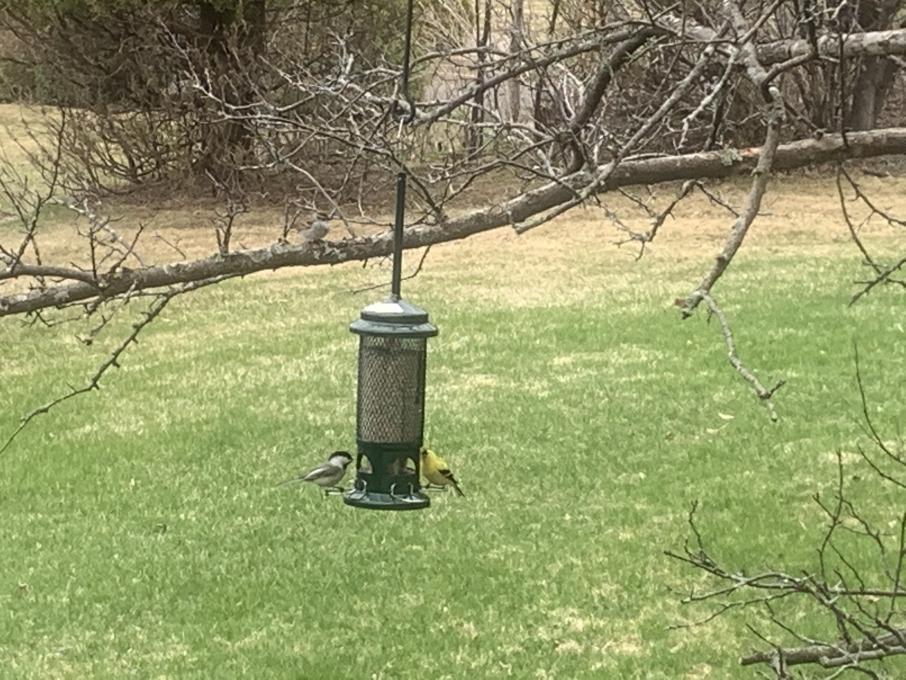
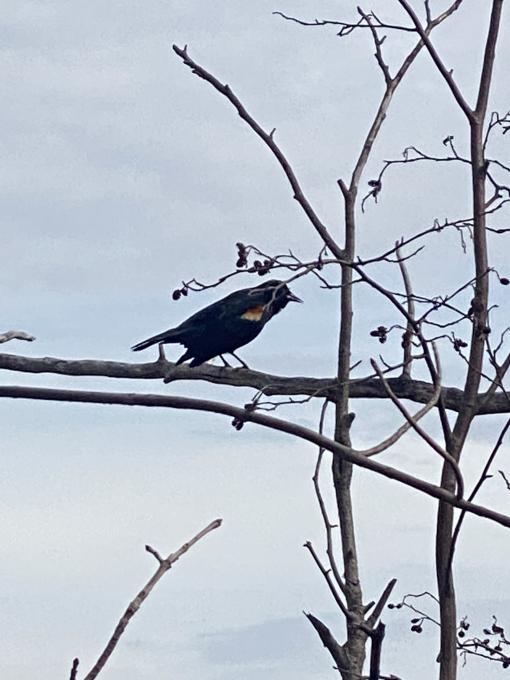 This section's activities prompted us to use our local Audubon Society's bird map to explore locales new to us. Cornell's E-bird site led us to lesser noted sites so as to seek out out less foot trafficked places. Using our optimized binoculars, and the well loved Merlin App, we identified buffleheads and a turkey vulture along the shore. The red-winged blackbirds were everywhere with their distinctive sounds. When we returned home the Black-capped chickadees were defending their territory (as usual) with the American Goldfinch. As Brown thrasher's have taken up residence in Arborvitaes adjacent to the bird feeder the Chickadees have been forced to relocate to yews in the backyard. Thanks to the course we're using bird behavior as an added discriminator for bird identification!
This section's activities prompted us to use our local Audubon Society's bird map to explore locales new to us. Cornell's E-bird site led us to lesser noted sites so as to seek out out less foot trafficked places. Using our optimized binoculars, and the well loved Merlin App, we identified buffleheads and a turkey vulture along the shore. The red-winged blackbirds were everywhere with their distinctive sounds. When we returned home the Black-capped chickadees were defending their territory (as usual) with the American Goldfinch. As Brown thrasher's have taken up residence in Arborvitaes adjacent to the bird feeder the Chickadees have been forced to relocate to yews in the backyard. Thanks to the course we're using bird behavior as an added discriminator for bird identification! 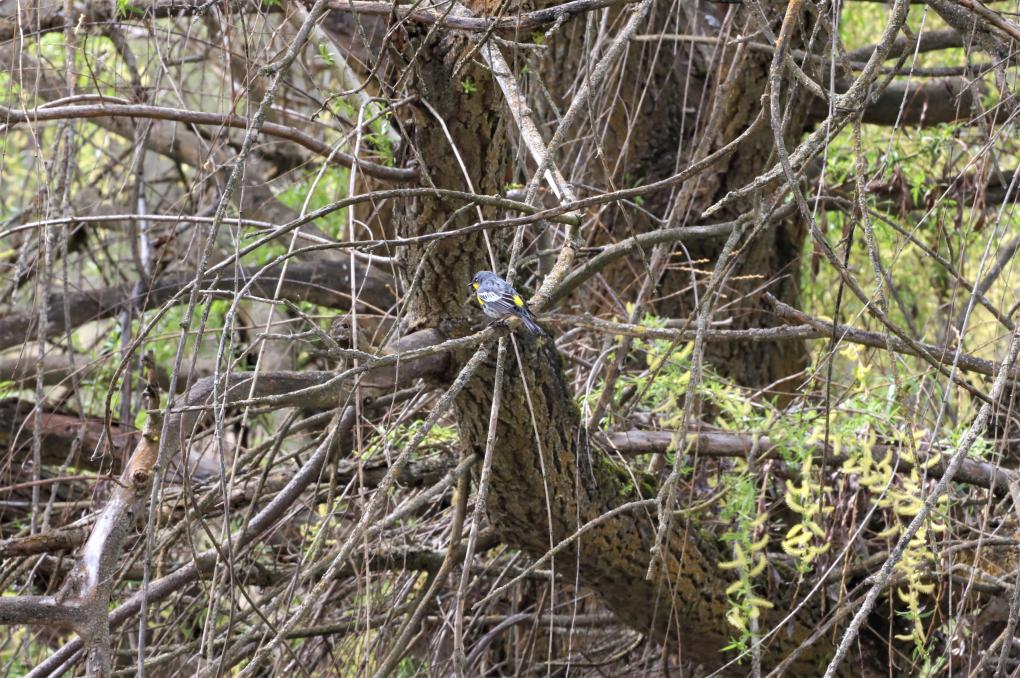
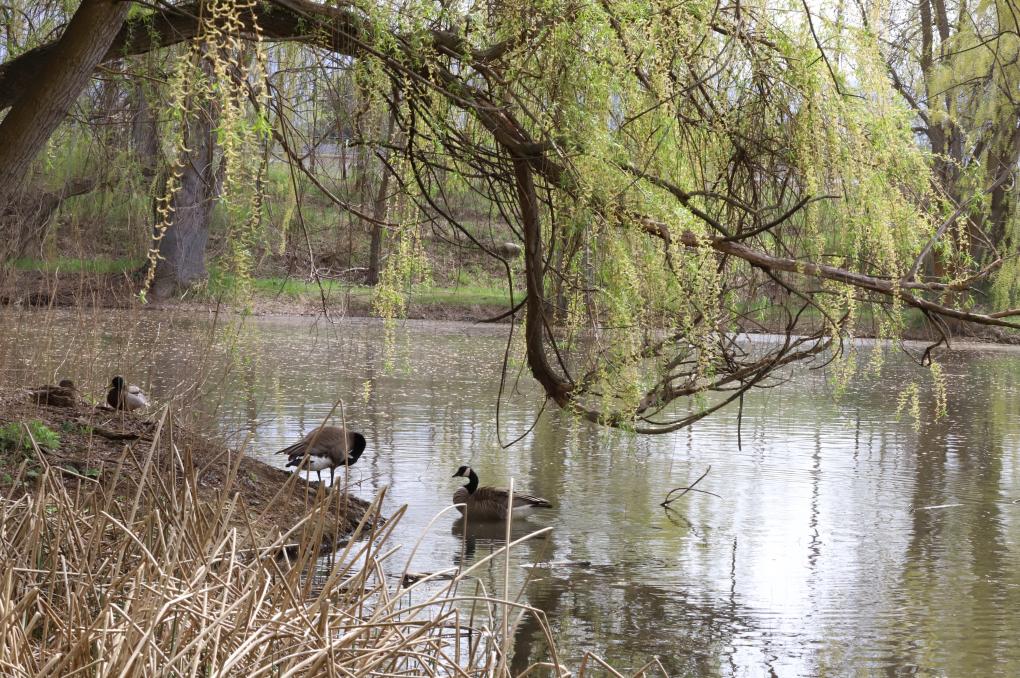
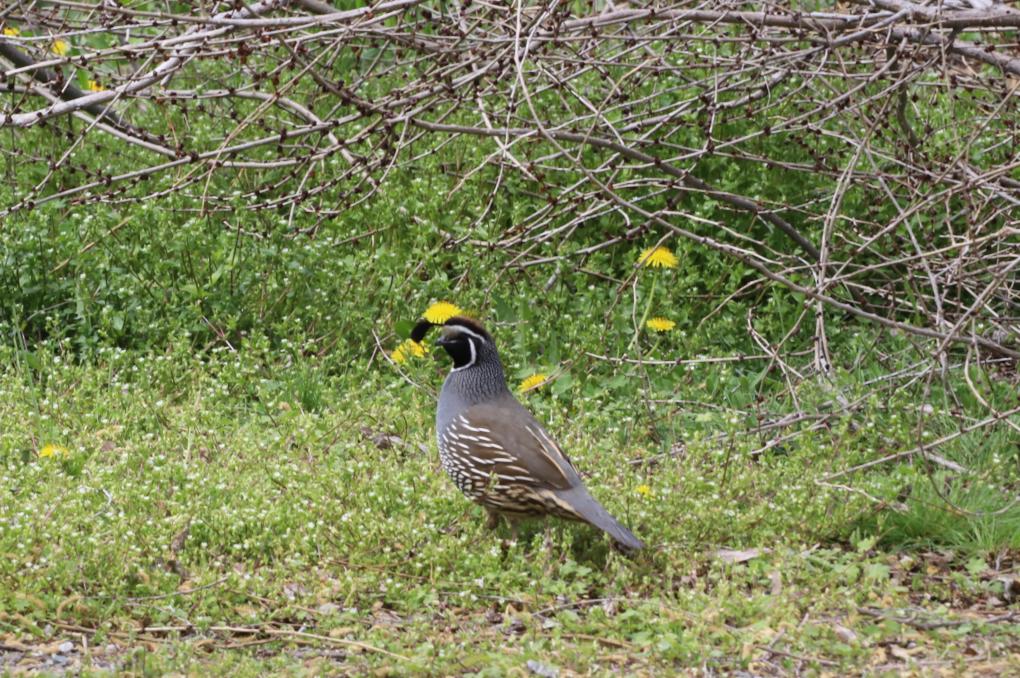
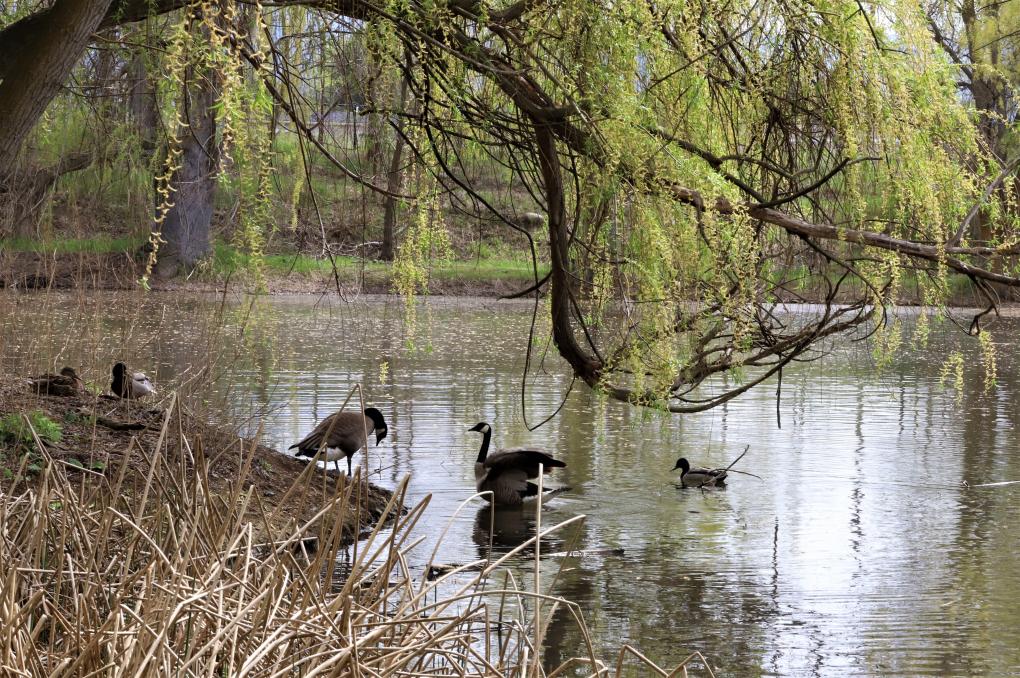 Activity 1: I went to one of our many marsh areas. There were the usual Mallards, Canada Geese, red-winged Blackbirds, Yellow-rumped Warblers which I am seeing for the first time (this is their breeding area), sparrows (I think they were Song Sparrows but they were moving in and around thick bush), American Robin (I have seen these my whole life and I did not know the full name. We have always said it is spring when we see the Robins). I love to watch the California quail; so cute. Didn't see any little ones yet. I heard what I think was Chickadees, but they were very high up in the trees. There were some big nests up there too, but I did not see any birds around them. Owls do inhabit this area.
Activity 1: I went to one of our many marsh areas. There were the usual Mallards, Canada Geese, red-winged Blackbirds, Yellow-rumped Warblers which I am seeing for the first time (this is their breeding area), sparrows (I think they were Song Sparrows but they were moving in and around thick bush), American Robin (I have seen these my whole life and I did not know the full name. We have always said it is spring when we see the Robins). I love to watch the California quail; so cute. Didn't see any little ones yet. I heard what I think was Chickadees, but they were very high up in the trees. There were some big nests up there too, but I did not see any birds around them. Owls do inhabit this area. 